PEP人教英语五年级下册Unit 5 Whose dog is it教案
- 格式:doc
- 大小:83.50 KB
- 文档页数:14
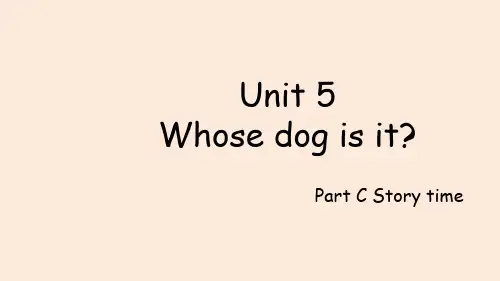
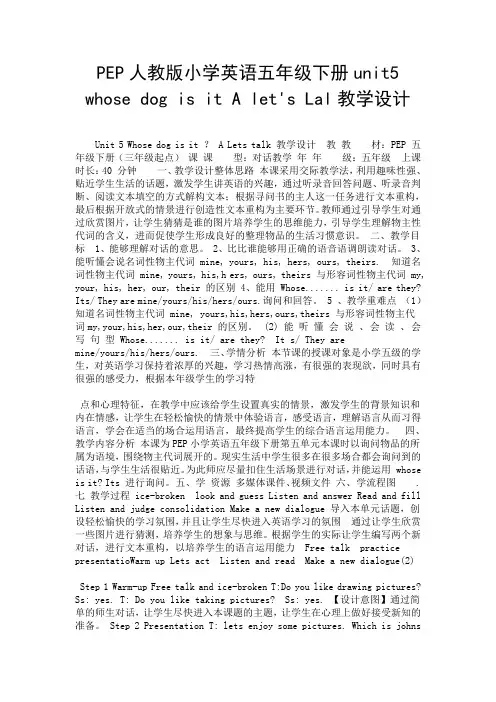
PEP人教版小学英语五年级下册unit5whose dog is it A let's Lal教学设计Unit 5 Whose dog is it ? A Lets talk 教学设计教教材:PEP 五年级下册(三年级起点)课课型:对话教学年年级:五年级上课时长:40 分钟一、教学设计整体思路本课采用交际教学法,利用趣味性强、贴近学生生活的话题,激发学生讲英语的兴趣,通过听录音回答问题、听录音判断、阅读文本填空的方式解构文本;根据寻问书的主人这一任务进行文本重构,最后根据开放式的情景进行创造性文本重构为主要环节。
教师通过引导学生对通过欣赏图片,让学生猜猜是谁的图片培养学生的思维能力,引导学生理解物主性代词的含义,进而促使学生形成良好的整理物品的生活习惯意识。
二、教学目标 1、能够理解对话的意思。
2、比比谁能够用正确的语音语调朗读对话。
3、能听懂会说名词性物主代词 mine, yours, his, hers, ours, theirs. 知道名词性物主代词 mine, yours, his,h ers, ours, theirs 与形容词性物主代词 my,your, his, her, our, their 的区别 4、能用 Whose....... is it/ are they?Its/ They are mine/yours/his/hers/ours.询问和回答。
5 、教学重难点(1)知道名词性物主代词 mine, yours,his,hers,ours,theirs 与形容词性物主代词my,your,his,her,our,their 的区别。
(2) 能听懂会说、会读、会写句型 Whose....... is it/ are they? It s/ They aremine/yours/his/hers/ours. 三、学情分析本节课的授课对象是小学五级的学生,对英语学习保持着浓厚的兴趣,学习热情高涨,有很强的表现欲,同时具有很强的感受力,根据本年级学生的学习特点和心理特征,在教学中应该给学生设置真实的情景,激发学生的背景知识和内在情感,让学生在轻松愉快的情景中体验语言,感受语言,理解语言从而习得语言,学会在适当的场合运用语言,最终提高学生的综合语言运用能力。
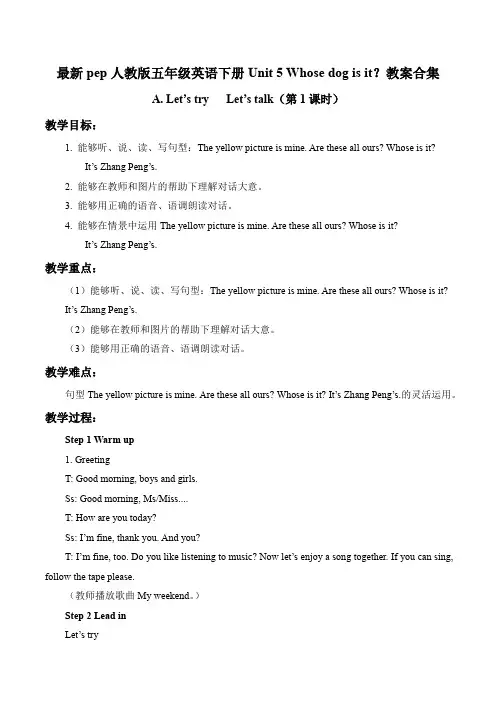
最新pep人教版五年级英语下册Unit 5 Whose dog is it?教案合集A. Let’s try Let’s talk(第1课时)教学目标:1. 能够听、说、读、写句型:The yellow picture is mine. Are these all ours? Whose is it?It’s Zhang Peng’s.2. 能够在教师和图片的帮助下理解对话大意。
3. 能够用正确的语音、语调朗读对话。
4. 能够在情景中运用The yellow picture is mine. Are these all ours? Whose is it?It’s Zhang Peng’s.教学重点:(1)能够听、说、读、写句型:The yellow picture is mine. Are these all ours? Whose is it?It’s Zhang Peng’s.(2)能够在教师和图片的帮助下理解对话大意。
(3)能够用正确的语音、语调朗读对话。
教学难点:句型The yellow picture is mine. Are these all ours? Whose is it? It’s Zhang Peng’s.的灵活运用。
教学过程:Step 1 Warm up1. GreetingT: Good morning, boys and girls.Ss: Good morning, Ms/Miss....T: How are you today?Ss: I’m fine, thank you. And you?T: I’m fine, too. Do you like listening to music? Now let’s enjoy a song together. If you can sing, follow the tape please.(教师播放歌曲My weekend。
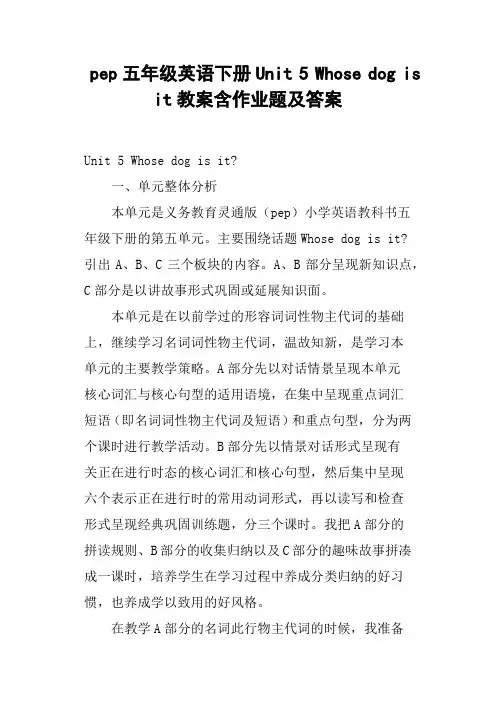
pep五年级英语下册Unit 5 Whose dog is it教案含作业题及答案Unit 5 Whose dog is it?一、单元整体分析本单元是义务教育灵通版(pep)小学英语教科书五年级下册的第五单元。
主要围绕话题Whose dog is it?引出A、B、C三个板块的内容。
A、B部分呈现新知识点,C部分是以讲故事形式巩固或延展知识面。
本单元是在以前学过的形容词词性物主代词的基础上,继续学习名词词性物主代词,温故知新,是学习本单元的主要教学策略。
A部分先以对话情景呈现本单元核心词汇与核心句型的适用语境,在集中呈现重点词汇短语(即名词词性物主代词及短语)和重点句型,分为两个课时进行教学活动。
B部分先以情景对话形式呈现有关正在进行时态的核心词汇和核心句型,然后集中呈现六个表示正在进行时的常用动词形式,再以读写和检查形式呈现经典巩固训练题,分三个课时。
我把A部分的拼读规则、B部分的收集归纳以及C部分的趣味故事拼凑成一课时,培养学生在学习过程中养成分类归纳的好习惯,也养成学以致用的好风格。
在教学A部分的名词此行物主代词的时候,我准备采用借助于图画、PPT课件等进行多功能训练,在教学B 部分动词正在进行时态形式时,我准备采用动画展示、图卡多种方式进行学习与巩固,鼓励学生积极参与砸金蛋、表演等多种活动,帮助学生培养好的学习心态,提高学习兴趣和学习质量。
二、单元教学目标1.知识目标(1)能够听、说、读、写本单元出现的mine,yours,his,hers,theirs,ours,climbing,eating,playing,jumping,drinking,sleeping等12个重点单词。
(2)能够听说认读本单元出现的each,ea,excited,like等词汇。
(3)能够听说读写本单元出现重点句型Look! Thats my dog! Yes! Its your dog. The dog is youFido is sleeping. Yes. Hes so cute! Aabbits eating? No. Theyre playing with ea(4)能够掌握主要功能句型。
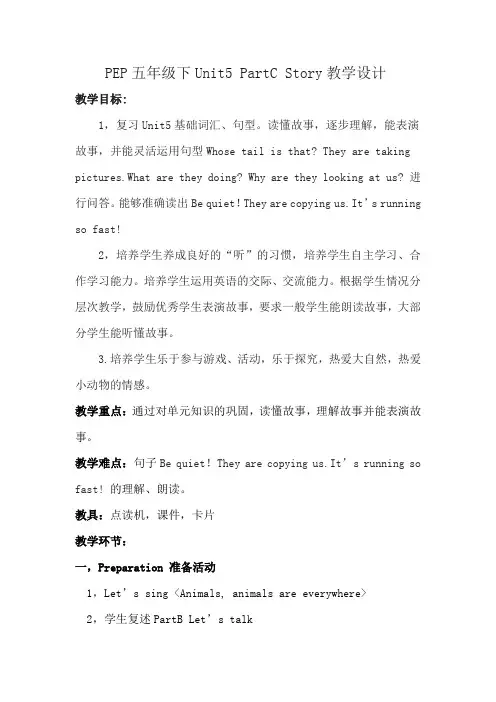
PEP五年级下Unit5 PartC Story教学设计教学目标:1,复习Unit5基础词汇、句型。
读懂故事,逐步理解,能表演故事,并能灵活运用句型Whose tail is that? They are taking pictures.What are they doing? Why are they looking at us? 进行问答。
能够准确读出Be quiet!They are copying us.It’s running so fast!2,培养学生养成良好的“听”的习惯,培养学生自主学习、合作学习能力。
培养学生运用英语的交际、交流能力。
根据学生情况分层次教学,鼓励优秀学生表演故事,要求一般学生能朗读故事,大部分学生能听懂故事。
3.培养学生乐于参与游戏、活动,乐于探究,热爱大自然,热爱小动物的情感。
教学重点:通过对单元知识的巩固,读懂故事,理解故事并能表演故事。
教学难点:句子Be quiet!They are copying us.It’s running so fast!的理解、朗读。
教具:点读机,课件,卡片教学环节:一,Preparation 准备活动1,Let’s sing <Animals, animals are everywhere>2,学生复述PartB Let’s talk【设计意图】通过学生的汇报,检查上一节课的内容,训练学生的口语表达能力及记忆能力。
二,Pre-reading阅读前活动1,Let’s do: Can you copy it?(教师示范帮助学生理解单词copy,并板书领读)2,动词ing形式的巩固动词原形动词ing形式run runningjump jumpingswim swimmingwrite writingsleep sleepinglook lookingdrink drinkingtake takingclimb climbingI am drinking water.The dogs are sleeping.教师出示动词原形的课件,学生迅速说出其动词ing形式,并用其ing形式说句子,在教师示范后,可以在小组内进行活动。
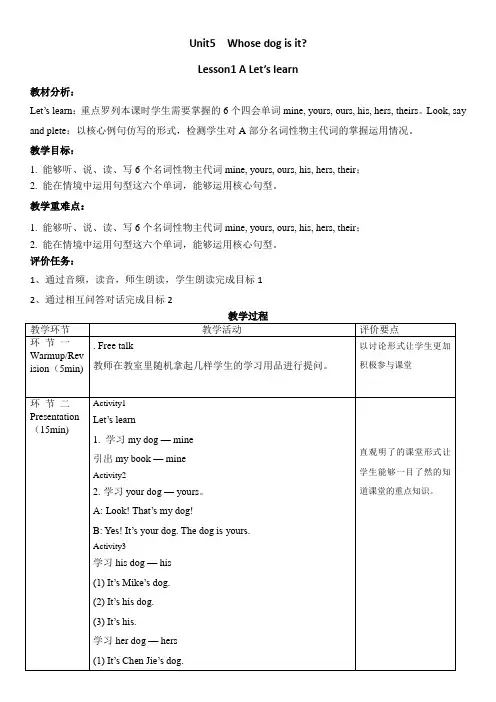
Unit5 Whose dog is it?
Lesson1 A Let’s learn
教材分析:
Let’s learn:重点罗列本课时学生需要掌握的6个四会单词mine, yours, ours, his, hers, theirs。
Look, say and plete:以核心例句仿写的形式,检测学生对A部分名词性物主代词的掌握运用情况。
教学目标:
1. 能够听、说、读、写6个名词性物主代词mine, yours, ours, his, hers, their;
2. 能在情境中运用句型这六个单词,能够运用核心句型。
教学重难点:
1. 能够听、说、读、写6个名词性物主代词mine, yours, ours, his, hers, their;
2. 能在情境中运用句型这六个单词,能够运用核心句型。
评价任务:
1、通过音频,读音,师生朗读,学生朗读完成目标1
2、通过相互问答对话完成目标2
板书设计:
Unit 5 Whose dog is it?
Part A Let’s learn Look, say and plete
mine yours his hers theirs ours 课后反思。
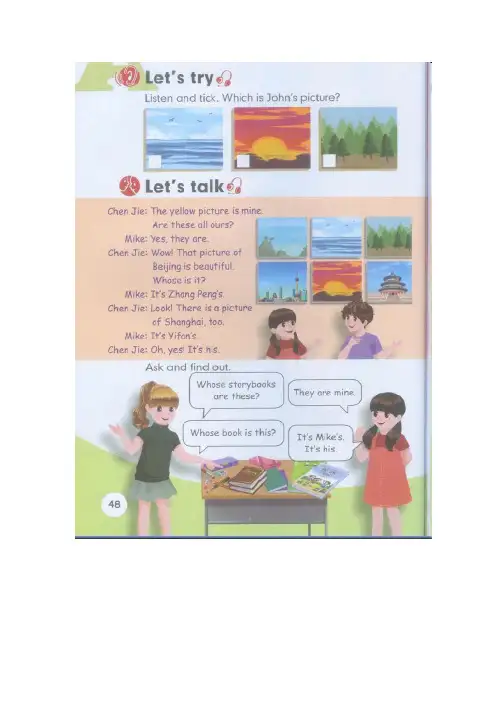
Unit 5 Whose dog is it?A Let’s talk教学设计教材:PEP 五年级下册(三年级起点)课型:对话教学年级:五年级上课时长:40分钟一、教学设计整体思路本课采用交际教学法,利用趣味性强、贴近学生生活的话题,激发学生讲英语的兴趣,通过听录音回答问题、听录音判断、阅读文本填空的方式解构文本;根据寻问书的主人这一任务进行文本重构,最后根据开放式的情景进行创造性文本重构为主要环节。
教师通过引导学生对通过欣赏图片,让学生猜猜是谁的图片培养学生的思维能力,引导学生理解物主性代词的含义,进而促使学生形成良好的整理物品的生活习惯意识。
二、教学目标1、能够理解对话的意思。
2、比比谁能够用正确的语音语调朗读对话。
3、能听懂会说名词性物主代词mine, yours, his, hers, ours, theirs.知道名词性物主代词mine, yours, his,h ers, ours, theirs与形容词性物主代词my, your, his, her, our, their的区别4、能用Whose....... is it/ are they? It’s/ They are mine/yours/his/hers/ours.询问和回答。
5、教学重难点(1)知道名词性物主代词mine, yours,his,hers,ours,theirs与形容词性物主代词my,your,his,her,our,their的区别。
(2)能听懂会说、会读、会写句型Whose....... is it/ are they? It’s/ They are mine/yours/his/hers/ours.三、学情分析本节课的授课对象是小学五级的学生,对英语学习保持着浓厚的兴趣,学习热情高涨,有很强的表现欲,同时具有很强的感受力,根据本年级学生的学习特点和心理特征,在教学中应该给学生设置真实的情景,激发学生的背景知识和内在情感,让学生在轻松愉快的情景中体验语言,感受语言,理解语言从而习得语言,学会在适当的场合运用语言,最终提高学生的综合语言运用能力。
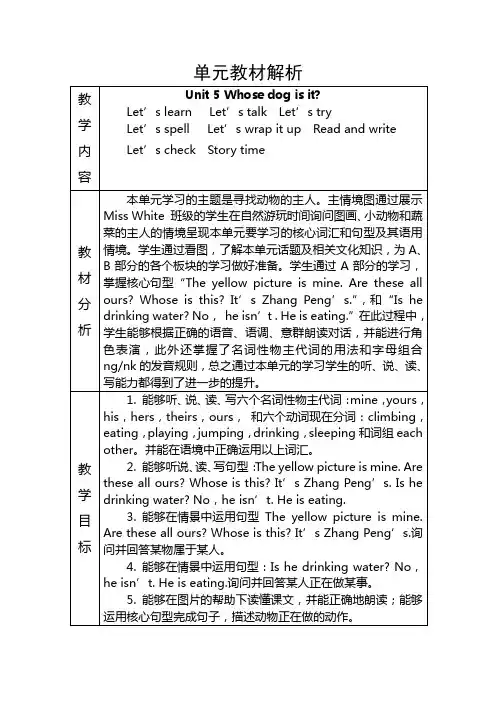
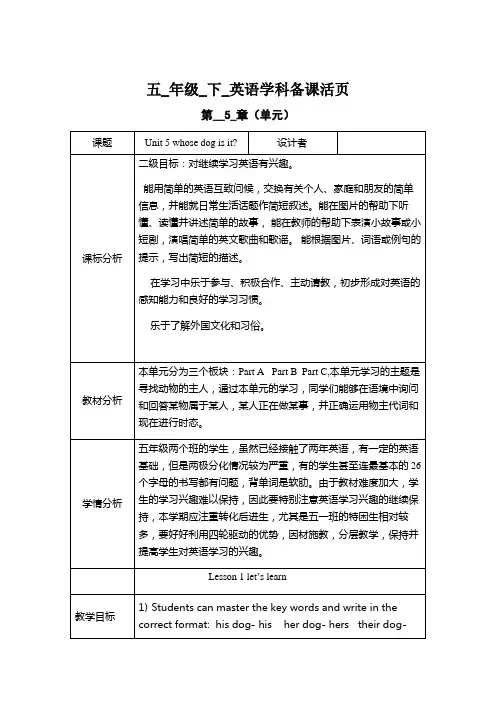
五_年级_下_英语学科备课活页
第__5_章(单元)
their dog = theirs
形容词性物主代词:起形容词的作用,用在名词前。
名词性物主代词:起名词的作用,后面无名词。
形容词性物主代词+名词= 名词性物主代词
3、讲解本课重点句型,并进行操练。
This is his desk. This desk is his.
That is her skirt. That skirt is hers.
...
六.拓展
七、总结反刍
学科班长带领大家总结本科的学习内容,教师补充。
八、当堂检测
选出不同类的单词。
() (1)A. that B. ours C. this
() (2) A. me B. mine C. yours
() (3)A. theirs B. ours C. him
二、用名词性物主代词填空。
(1) It's his cap. It's ________.
(2) It's her cat. It's ________.
(3) It's their classroom. It's ________. 九.Homework
1.Read and write the text three times.
2..Preview next lesson. 此环节为课后作业环节,包括复习和预习两部分,预习作为“读书自学,自主探究”与下一节课的“完成学案二次探究”形成闭环。
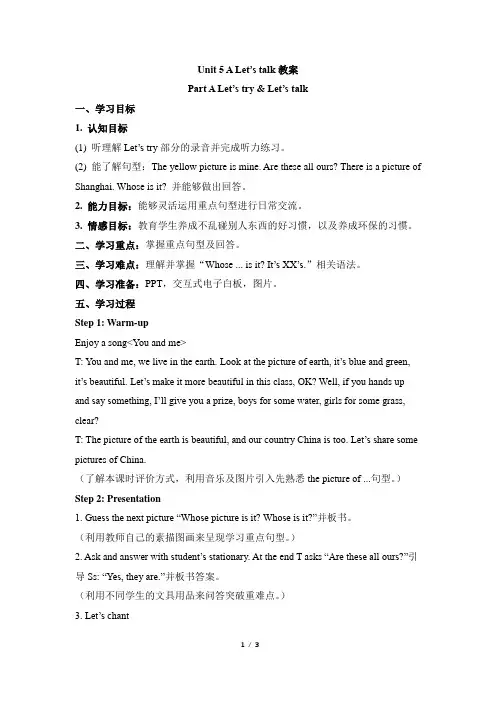
Unit 5 A Let’s talk教案Part A Let’s try & Let’s talk一、学习目标1. 认知目标(1) 听理解Let’s try部分的录音并完成听力练习。
(2) 能了解句型:The yellow picture is mine. Are these all ours? There is a picture of Shanghai. Whose is it? 并能够做出回答。
2. 能力目标:能够灵活运用重点句型进行日常交流。
3. 情感目标:教育学生养成不乱碰别人东西的好习惯,以及养成环保的习惯。
二、学习重点:掌握重点句型及回答。
三、学习难点:理解并掌握“Whose ... is it? It’s XX’s.”相关语法。
四、学习准备:PPT,交互式电子白板,图片。
五、学习过程Step 1: Warm-upEnjoy a song<You and me>T: You and me, we live in the eart h. Look at the picture of earth, it’s blue and green, it’s beautiful. Let’s make it m ore beautiful in this class, OK? Well, if you hands up and say something, I’ll give you a prize, boys for some water, girls for some grass, clear?T: The picture of the earth is beautiful, and our country China is too. Let’s share some pictures of China.(了解本课时评价方式,利用音乐及图片引入先熟悉the picture of ...句型。
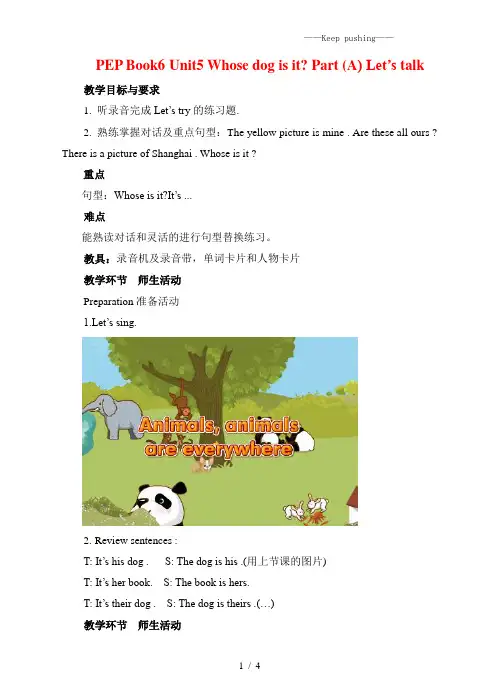
PEP Book6 Unit5 Whose dog is it? Part (A) Let’s talk 教学目标与要求1. 听录音完成Let’s try的练习题.2. 熟练掌握对话及重点句型:The yellow picture is mine . Are these all ours ? There is a picture of Shanghai . Whose is it ?重点句型:Whose is it?It’s ...难点能熟读对话和灵活的进行句型替换练习。
教具:录音机及录音带,单词卡片和人物卡片教学环节师生活动Preparation准备活动1.Let’s sing.2.Review sentences :T: It’s his dog . S: The dog is his .(用上节课的图片)T: It’s her book. S: The book is hers.T: It’s their dog . S: The dog is theirs .(…)教学环节师生活动Presentation新知呈现1.Let’s try.教师播放Let-s try部分的录音,学生完成听音打勾练习。
教师再次播放Let -s try部分的录音,然后问学生:Which is John's picture?要求学生根据所听到的的内容回答。
2.Let’s talk(1)敦师播放Let -s talk部分的录音,请学生认真听,思考以下问题:①Which picture is Chen Jie's?②Whose is the picture of Beijing? Whose is it?③Whose is the picture of Shanghai? Whose is it?(2)教师播放录音,学生回答这三个问题。
①The yellow picture is Chenjie's. It's his.②It-s Zhang Peng's.lt's his.③It's Yifan's. It-s his.(3)看图说话。
Unit Five Whose dog is it?单元教材分析本单元是义务教育PEP小学英语教科书五年级下册教材第五单元,单元学习的主题是寻找动物的主人,重点学习内容是名词性物主代词及现在进行时。
单元围绕话题Whose dog is it? 引出两组情景对话、一篇小阅读和一个趣味故事,功能是运用句型询问并表达物品的所属关系,并在此基础上培养学生的语言交际能力和“用英语做事情”的能力。
本单元的内容与日常生活息息相关,容易激发学生的学习兴趣和思想共鸣,便于学生在学习中体验、理解、内化和运用。
本单元在复习以前学过的一些形容词性物主代词的基础上,进一步学习名词性物主代词的使用,并在不同的情景下理解动词进行时态的正确使用,学会独立表Whose … is it? It’s …Whose … are these/those? They’re … What is/are … doing? … is/are V-ing. 等功能语句进行语言交际,解决现实生活中关于此类话题的问题,并培养学生对身边事物细致的观察力。
单元分A, B, C三部分。
A部分重点学习名词性物主代词mine,yours, his, hers, theirs, ours的用法,并掌握核心句型Whose … is it? It’s … Whose …are these/those? They’re …询问和回答某物属于某人。
Let’s spell 要求掌握字母组合ng/nk的发音规律,听音能读写符合发音规则的单词。
B部分让学生初步接触、学习现在分词与现在进行时时态的用法。
重点学习动词现在分词climbing, eating, playing, jumping, drinking, sleeping,并能在情景中运用句型Is he drinking water? No, he isn’t. He’s eating. 询问并回答某人正在做某事。
Read and write部分要求学生能在图片和教师的帮助下读懂韵文,能按照正确的意群及语音语调朗读,能够运用核心句型完成句子描述动物正在做的动作。
人教版小学五年级下册英语Unit5《Whose dog is it?》第二课时教学设计教学内容 Part A Let’s learn & Look, say and complete教学目标1.能够正确听﹑说﹑读﹑写词汇,如hers, mine, his, theirs,yours 和ours等名词性物主代词。
2.能正确听,说,朗读“Whose… is it?It’s…”等询问和回答物品归属的交际用语。
3.能听懂,会说Let’s learn的内容,并根据实际情况运用本课重点句型表达物品的归属。
4.能完成“Look, say and complete”部分的任务。
5.通过学习,激发学生用英语进行交流的热情,继续保持学生对学习英语的兴趣。
教学重点1.能够正确听﹑说﹑读﹑写词汇,如hers, mine, his, theirs 和ours等名词性物主代词。
2.能正确听,说,朗读“Whose… is it?It’s…”等询问和回答物品归属的交际用语。
教学难点学生能够大胆创编和表演有关物品归属的问答小对话。
教学设备多媒体课件﹑四线三格磁条黑板贴﹑课本光碟教学过程Step 1 Warming-upSing a chant.T:Please stand up! Listen to me. Sing a chant after me. And you do the actions. Here we go!(播放动感伴奏)T: Dog dog dog, whose dog is it?S: Dog dog dog, it’s my dog.T: Dog dog dog, whose dog is it?S: Dog dog dog, it’s her dog.T: Dog dog dog, whose dog is it?S: Dog dog dog, it’s his dog.T: Dog dog dog, whose dog is it?S: Dog dog dog, it’s our dog.T: Dog dog dog, whose dog is it?S: Dog dog dog, it’s their dog.T: Dog dog dog, whose dog is it?S: Dog dog dog, it’s your dog.Step 2 Presentation & Practice1.学习单词yours, hers, his, ours, theirs, mine。
Unit 5 Whose dog is it ? 第一课时 教学内容:A. Let’s learn A. Look, say and complete 教学目标: 知识与技能: 1.、掌握名词性物主代词:mine, yours, his, hers, theirs, ours。 2.、能用句子:“It’s mine/yours/hers/his.”来标明物品的所属情况。 过程与方法:能在课堂的活动中运用所学的语言进行交际。 情感与价值观:1、帮助学生热爱动物、大自然的美好情感。 2、培养学生团队合作的精神和自主学习的意识。 学习重、难点:1、重点:掌握名词性物主代词的拼读与用法 2、难点:1)区分形容词性无助代词和名词性物主代词的不同。 2)在语境、合作、交流中体会并理解物主代词的用法。 教具准备:PPT 教学过程: Step 1: Warm-up 1. 学生欣赏Unit5的歌曲《Animals, Animals are everywhere》 2. 教师出示歌曲中的动物图片,然后进行抢答活动。 3. 活动 让四名同学带上自己的钢笔到讲台上来并举起钢笔介绍It’s my pen.然后让几名同学背对大家互相交换手中的钢笔并交换所占位置然后请其中一个同学凭自己的记忆猜猜钢笔的所属。This is his pen. This is her pen. This is my pen.等。 Step 2: Presentation 1. 教学Let’s learn (1)教师介绍犬展天下-----Dog Show犬展开始了,让我们去看看各类高端大气上档次的狗狗们是谁家的? (2)学习单词his和hers 课件出示Let’s learn 部分的画面,教师指着第一只狗说:Look! This is his dog. It’s his. That’s her dog. It’s hers.然后出示单词卡片his 和hers.并请全班跟读。 板书his dog=his her dog=hers 学习单词ours 和theirs (3)教师指着课本第二幅图,用上面的方法学习ours 和theirs,然后指着某张课桌对全班说This is their desk. It’s theirs. 出示校长照片说:She’s/He’s our head master. He’s ours.然后出示单词ours和theirs.全班学生跟读并拼写。 (4)学习单词mine和yours 教师指着自己的书包说:This is my bag. It’s mine.指着某个人的书包对他、她说:This is your bag. It’s yours.然后出示单词进行操练。 (5)教师总结找出两种物主代词的区别。 My pen=mine----This pen is mine. Her bag=hers----This bag is hers. His eraser=his----This eraser is his. Your ruler=yours----This ruler is yours. (6) 活动 教师拿起自己的一本书说:This book is mine.让学生拿起自己或者别人的物品说:It’s mine./hers/his/ours/theirs/yours.帮助学生熟悉和理解物主代词的含义及其用法。 2、 教学Look, say and complete 出示49页表格学生阅读并填写模仿例句完成一问一答。 如:Whose book is that? It’s Amy’s book. The book is hers. Whose pen is that? It’s John’s pen. The pen is his. Step 3: Practice 活动:物归原主 教室把“失物招领”中的物品展示给学生看,请学生帮助寻找这些物品的主人,完成“物归原主”的任务。 如:Is this your...? Yes ,it’s mine.或No, it isn’t. Step 4: Check 一、连一连,并读一读。 mine ours his hers whose yours theirs 他们的 谁的 我的 你的 她的 他的 我们的 二、快乐二选一,然后在读一读。 1. The blue pencil is __________ (my,mine ) 2. This is not my dog .It’s _________ ( she , hers) 3. –Whose picture are these ? --They are _________( we ,ours) 4. Is this __________ (Amy, Amy’s ) desk ? 5. The white cat is _______ (he, his ). Step 5: Summary 作业设计 1. 熟记本课所学的四会句子。 2. 找出家中的几件物品,向同学炫耀物品的归属。 板书设计 Unit 5 Whose dog is it ? his dog-------his her dog-----hers their dog----theirs our dog----ours my dog-----mine your dog----yours 教后反思: 用心听他人说英语。学习英语是从“听”起步的。“听”是“说 ”的前提,没有“听”,就无从模仿“说”。只有听得清,听得懂,才能说得准,说得好。用心地多听他人说英语,有助于培养对英语的敏捷反应。
第二课时 教学内容:A. Let’s try、A. Let’s talk 教学目标: 知识与技能: 1. 听录音完成Let’s try的练习题. 2. 熟练掌握对话及重点句型:The yellow picture is mine . Are these all ours ? There is picture of Shanghai . Whose is it ? 过程与方法:能在课堂的活动中运用所学的语言进行交际。 情感与价值观:1、帮助学生热爱动物、大自然的美好情感。 2、培养学生团队合作的精神和自主学习的意识。 学习重、难点:1、能听录音完成相应的练习题。 2、能熟读对话和灵活的进行句型替换练习。 教具准备:PPT 教学过程: Step 1: Warm-up 1. 教师出示一些物体,和学生进行问答练习。 T: Is this his cat ? S: Yes, it is . T: Is this her bag ? S: No, it isn’t. ( 板书) T: Whose book / pen /ruler is that ? S1: It’s mine/ yours/his . 2. 复习句子 : T: It’s his dog . S: The dog is his .(用上节课的图片) T: It’s her book. S: The book is hers. T: It’s their dog . S: The dog is theirs .(…) Step 2: Presentation 1. 听录音,完成Let’s try部分的联系。 (老师讲解录音中的重点句子) 2. 学习关键的词语和句子: yellow picture, picture of , beautiful, There is … (板书在黑板上) 3. T: Is this a yellow picture ? S: Yes, it is . T: That is a picture of Beijing. S: Read it . T: There is a beautiful picture. S: Read it “beautiful “ 4. 听talk部分录音,并跟读。 T: Look here .There are so many pictures . S; Yes. T: The yellow picture is ChenJie’s . The yellow picture is hers . T: Whose is that picture of Beijing ? S: It’s Zhang Peng’s . T: Whose is that picture of Shanghai ? S: It’s Yifan’s . 5. 学生读talk,小组操练。 1)活动: 失物招领,灵活掌握本节课的句型 S1: Whose storybooks are these ? S2: They are mine . S1: Whose book is this ? S2: It’s Mike’s ./ It’s his . 2) 分角色朗读talk部分 Step 3: Check 1、根据课文内容判断正确的用T错误的用F。 ( ) 1. The yellow picture is Mike’s . ( ) 2. That picture of Beijing is beautiful. ( ) 3. That picture of Shanghai is Zhang Peng’s. 2、同义句对对碰。 1. Is this your book ? A. This is my red bag . 2. The red bag is mine . B. Is the book yours ? 3. This is Chen Jie’s chair . C. This is a beautiful picture of spring. 4. This picture of spring is beautiful. D. This chair is Chen Jie’s. 3、根据短文内容选词填空。(也可做听力,老师念) A. get up B. live on C. breakfast D. face E. play sports My name is Robinson. I 1.________ an island . I always 2.________ early every day . I wash my 3._______ ,and then I eat 4.________. Sometimes I clean my cave, too. In the afternoon ,I 5._________ with my friend. 4、单项选择。 ( ) 1. The yellow picture is __________. A. mine B. my C. I ( ) 2. Are these all _________ ? A. our B. my C. ours ( ) 3. That picture _________ Beijing is beautiful. A. on B. at C. of ( ) 4. --_________ dress is this ? -- It’s __________. A. What ; Sarah’s B. Whose ; Sarah C. Whose ; Sarah’s Step 4 Summary 作业设计 1、熟读Let’s talk部分。 2、抄写Let’s talk部分并写出汉语意思。 板书设计 Unit 5 Whose dog is it ? The yellow picture is mine .